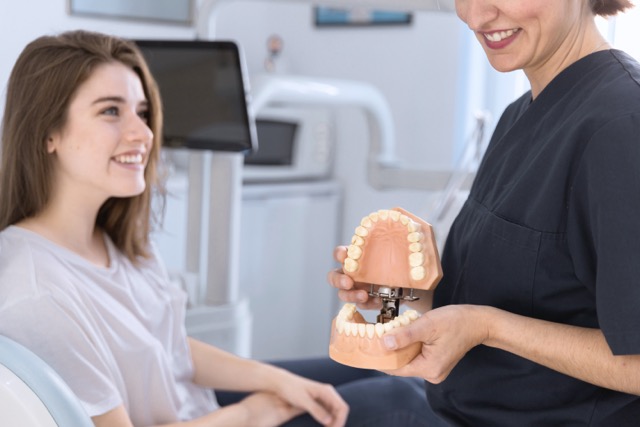Why Do White Spots Appear on Teeth and How to Remove Them

Contents
- 1 What Are White Spots on Teeth?
- 2 Common Causes of White Spots on Teeth
- 3 How to Remove White Spots on Teeth: Treatment Options
- 4 What to do if white spots have already appeared on your teeth? The treatment depends on the cause. After a professional examination of your oral cavity, a dentist can offer different at-home and in-office remedies to manage tooth discoloration.
- 5 If white stains are the result of enamel hypoplasia, you might not need to treat them. It’s only a cosmetic issue then.
- 6 Can White Spots Be Prevented?
- 7 Maintaining several dental practices can prevent white stains from developing:
- 8 Frequently Asked Questions About White Spots on Teeth

If you dream about a luminous smile, seeing milk spots on teeth might give you hope that a tooth fairy has heard your moaning. However, white stains on teeth won’t develop into aesthetic veneers. It may be a sign of concern at times. What does white spots on your teeth mean? Can you prevent or remove them, and how to do it properly?
Our expert guide will clarify these and other questions related to white marks on teeth. Let’s “spot” the culprits for their emergence!
What Are White Spots on Teeth?
A white spot on a tooth is an area of discoloration that makes it look opaque in one place and white in another. This condition is often associated with the quality and thickness of the enamel, but it is not the sole cause of white spots on teeth. Except for looking unsightly, enamel spots on teeth can signify certain dental problems, so it’s better to address this issue as soon as you notice an occasional white patch.
Common Causes of White Spots on Teeth
If you puzzle over “Why do my teeth have white spots?”, consider a brief compilation of potential causes:
- Tooth demineralization. Enamel can gain decalcified areas due to prolonged accumulation of bacteria in the oral cavity. A tooth loses essential minerals along with its original coloration, increasing the risk of dental decay.
- Turner’s tooth (enamel hypoplasia). This tooth formation defect is characterized by white, yellow, or brown discoloration. It can spread on the entire crown sometimes, so it’s crucial to visit your dentist regularly to monitor this condition.
- Fluorosis. This cosmetic dental issue is caused by excess fluoride in the body. You can get the mineral from fluoride-enriched toothpastes, drinking tap water, or consuming special supplements.
- Poor oral hygiene. A deficit of attention to your dental hygiene can foster the development of bacterial plaque. If you don’t brush and floss your teeth routinely, bacteria can accumulate on teeth and put the color of enamel at risk.
- Harmful habits. Smoking, breathing through the mouth, sugary or acidic diet, and the consumption of highly pigmented foods and drinks create an unfavorable environment that triggers white patches on enamel.
- Certain medications. Some health issues and medications can cause teeth discoloration, especially during their formation. Uneven tooth development can lead to the appearance of white spots.
Meticulous dental care is not a panacea for white spots, but brushing and flossing your teeth twice a day is indispensable for oral health. If you wear braces or Invisalign trays, thorough oral hygiene can lessen the risk of tooth decay.
How to Remove White Spots on Teeth: Treatment Options
What to do if white spots have already appeared on your teeth? The treatment depends on the cause. After a professional examination of your oral cavity, a dentist can offer different at-home and in-office remedies to manage tooth discoloration.
| Professional treatment options | At-home care |
| Topical fluoride. Intensified fluoride gels, toothpastes, mouthwashes, and varnishes promote enamel strengthening and prevent spots aggravation. | Reconsider your dental hygiene. Brush your teeth twice a day for two minutes and don’t skip daily flossing. |
| Enamel microabrasion+teeth whitening. A dental expert can remove a tiny enamel layer before teeth whitening to smoothen the surface and reduce the appearance of white spots. | Reduce fluoride consumption. If a doctor determines that your white spots are caused by fluorosis, use a definite amount of toothpaste and drink bottled water. |
| Porcelain veneers. Thin ceramic shells can help conceal tooth discolorations and improve your smile aesthetics. | Rearrange your habits and dietary choices. Quit smoking if you do, eat tooth-friendly foods, and avoid sugary drinks to save your teeth from further damage. |
| Composite resin treatment. If white stains develop into cavities, a dental practitioner can fill them with a tooth-colored composite. | Schedule a dental appointment. During a dental check-up, a doctor can identify the cause of white spots and prescribe actionable remedies for tooth strengthening. |
If white stains are the result of enamel hypoplasia, you might not need to treat them. It’s only a cosmetic issue then.
Can White Spots Be Prevented?
Maintaining several dental practices can prevent white stains from developing:
- Practice good oral hygiene. It can help prevent discolorations and other tooth-related issues, such as gum disease and tooth decay.
- Avoid sugary and acidic products. Such foods and drinks can gradually damage tooth enamel and increase the risk of cavities.
- Rinse your mouth with water after meals. It will help neutralize the acids in your oral cavity and prevent plaque from accumulating.
- Avoid over-fluoridation. A professional dental examination can help reveal whether to use fluoride toothpaste or choose a more suitable alternative.
Keeping an eye on your oral health is vital to prevent white spots on teeth, while their treatment requires professional expertise. Enamel demineralization, Turner’s tooth, and fluorosis imply distinct therapy approaches. Seek professional evaluation as soon as possible to prevent bigger dental problems in the future.
Frequently Asked Questions About White Spots on Teeth
Are White Spots a Sign of Tooth Decay?
Not necessarily. It is true in the case of enamel hypoplasia, but milky spots can also appear because of excessive fluoride in the body or the intake of certain medications. Consult a dentist to identify the cause of your tooth discoloration.
Can white spots on teeth go away on their own?
On average, they won’t leave your teeth for good. White stains can be reversed only in the early stages of enamel demineralisation with timely treatment.
Are white spots on teeth permanent?
It depends on their cause. Even if a doctor states they are permanent, in-office professional remedies can help make them less noticeable and strengthen tooth enamel.
Additional Resources
To find out more about dental fluorosis, read this article by the National Library of Medicine.













